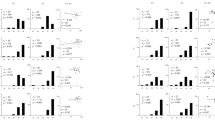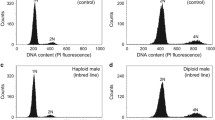Abstract
Field collections in Puerto Rico revealed 4 behaviorally distinct isolates ofMuscidifurax uniraptor Kogan & Legner that differed initially in diapause and nondiapause emergence, and the age when ♀ progeny were produced. Subsequent F1 and F2 progeny differed in sex ratio and total progeny production. Mating F2 ♀ ♀ from nondiapause isolates to naturally emerging ♂ ♂ from thelytokous populations significantly reduced total progeny and the proportion of ♀ ♀ toca. 20 %. These mated ♀ ♀ at first resembled in behavior those which originated from diapausing parents. Random mating within all isolates beginning in the F3, resulted in a general lower survival and progeny production but was accompanied by a rise in sex ratio toca. 50% ♀ ♀ by the F6 generation. The interinvolvement of extranuclear and genic factors is considered.
Résumé
Les récoltes effectuées à Puerto Rico ont révélé 4 isolats thélytoques deMuscidifurax uniraptor Kogan et Legner qui se différencient par leur comportement. Ils diffèrent d'abord par l'apparition ou non de la diapause, la descendance totale et le pourcentage des sexes dans la F1 et la F2. L'accouplement de ♀ ♀ F2 issues d'isolats non diapausants avec des ♂ ♂ thélytoques réduit d'une manière significative la descendance totale et la proportion des femelles à environ 20 %. Des femelles qui en provenaient ressemblaient d'abord, dans leur comportement, à celles issues de parents en diapause. Cependant, l'accouplement réalisé au hasard parmi tous les isolats commençant à la F3 entraînait en général une réduction de la survie et de la descendance accompagnée par une proportion des sexes d'environ 50 % de femelles par génération de F6. On examine les facteurs extranucléaires et génétiques.
Similar content being viewed by others
References
Abbott, W. S. — 1925. A method of computing the effectiveness of an insecticide. —J. Econ. Entomol., 18, 265–267.
Beale, G. &Knowles, J. — 1978. Extranuclear Genetics —Edward Arnold, London, 142 pp.
Birch, L. C. — 1948. The intrinsic rate of natural increase of an insect population. —J. Anim. Ecol., 17, 15–26.
Bull, J. J. — 1983. Evolution of Sex Determining Mechanisms. —The Benjamin/Cummings Publ. Co., Inc., Menlo Park, Calif., 316 p.
Corbet, S. A. — 1985. Insect chemosensory responses: a chemical legacy hypothesis. —Ecol. Entomol., 10, 143–153.
Duncan, D. B. — 1955. Multiple range and multiple F tests. —Biometrics, 11, 1–41.
Fleming, J. G. W., &Summers, M. D. — 1986.Campoletis sonorensis, endoparasitic wasps contain forms ofC. sonorensis virus DNA suggestive of integrated and extrachromosomal polydnavirus DNAs. —J. Virol., 57, 552–562.
Hey, J. &Gargiulo, M. K. — 1985. Sex-ratio changes inLeptopilina heterotoma in response to breeding. —The J. of Hered., 76, 290.
Kawooya, J. K. — 1983. Electrophorectic discrimination of species of theMuscidifurax [Hymenoptera: Pteromalidae] complex. —Ph. D. Dissertation, Univ. or Illinois, Urbana, 113 pp.
Kogan, M. &Legner, E. F. — 1970. A biosystematic revision of the genusMuscidifurax [Hymenoptera: Pteromalidae] with descriptions of four new species. —Can. Entomol., 102, 1268–2190.
Krell, P. J. &Stoltz, D. B. — 1979. Unusual baculovirus of the parasitoid wasp,Apanteles melanoscelus: isolation and preliminary characterization. —J. Virol., 29, 1118–1130.
Legner, E. F. — 1967. Behavior changes the reproduction ofSpalangia cameroni, S. endius, Muscidifurax raptor, andNasonia vitripennis [Hymenoptera: Pteromalidae] at increasing host densities. —Ann. Entomol. Soc. Am., 60, 819–826.
Legner, E. F. — 1969. Reproductive isolation and size variation in theMuscidifurax raptor complex. —Ann. Entomol. Soc. Am., 62, 382–385.
Legner, E. F. — 1979. Prolonged culture and inbreeding effects on reproductive rates of two pteromalid parasites of muscoid flies. —Ann. Entomol. Soc. Am., 72, 114–118.
Legner, E. F. — 1983. Broadened view ofMuscidifurax parasites associated with endophilous synanthropic flies and sibling species in theSpalangia endius complex. —Proc. Calif. Mosq. & Vect. Contr. Assoc., Inc., 51, 47–48.
Legner, E. F. — 1985a. Natural and induced sex ratio changes in populations of thelytokousMuscidifurax uniraptor [Hymenoptera: Pteromalidae]. —Ann. Entomol. Soc. Am., 78, 398–402.
Legner, E. F. — 1986. Breeding superior parasitoids of Diptera using a novel extranuclear inheritance mechanism. —Proc. Calif. Mosq. & Vect. Contr. Assoc., Inc., 44, 156–159.
Legner, E. F. — 1985b. Effects of scheduled high temperature on male production in thelytokousMuscidifurax uniraptor [Hymenoptera: Pteromalidae]. —Can. Entomol., 117, 383–389.
Legner, E. F. — 1987a. Transfer of thelytoky to arrhenotokousMuscidifurax raptor Girault & Sanders [Hymenoptera: Pteromalidae]. —Can. Entomol., 119, 265–271.
Legner, F. F. — 1987b. Inheritance of gregarious and solitary oviposition inMuscidifurax raptorellus Kogan & Legner [Hymenoptera: Pteromalidae]. —Can. Entomol., 119, 791–808.
Legner, E. F. &Gerling, D. — 1967. Host-feeding and oviposition onMusca domestica bySpalangia cameroni, Nasonia vitripennis, andMuscidifurax raptor [Hymenoptera: Pteromalidae] influences their longetivy and fecundity. —Ann. Entomol. Soc. Am., 60, 678–691.
Legner, E. F., Moore, I. &Olton, G. S. — 1976. Tabular keys and biological notes to the common parasitoids of synanthropic Diptera breeding in accumulated animal wastes. —Entomol. News 87, 113–144.
Mane, S. D., Tompkins, L., &Richmond, R. C. — 1983. Male esterase 6 catalyses the synthesis of a sex pheromone inDropsophila melanogaster females. —Science (Wash., D. C.), 222, 419–421.
Mudd, A. R., Fisher, C. &Smith, M. C. — 1982. Volatile hydrocarbons in the Dufour's gland of the parasiteNemeritis canescens (Grav.) [Hymenoptera: Ichneumonidae]. —J. Chem. Ecol., 8, 1035–1042.
Richmond, R. C. &Senior, A. — 1981. Esterase a6 (EC 3.1.1.1.) ofDrosophila melanogaster: kinetics of transfer to females, decay in females and male recovery. —J. Insect. Physiol. 27, 849–854.
Rössler, Y &De Bach, P. — 1972. The biosystematic relations between a thelytokous and an arrhenotokous form ofAphytis mytilaspidis (Le Baron) [Hymenoptera: Aphelinidae]. 1. The reproductive relations. —Entomophaga, 17, 391–423.
Slobodchikoff, C. N. — 1983. Why asexual reproduction?: variation in populations of the parthenogenetic wasp,Venturia canescens [Hymenoptera: Ichneumonidae]. —Ann. Entomol. Soc. Am., 76, 23–29.
Stanley-Samuelson, D. W. &Loher, W. — 1986. Prostaglandins in insect reproduction. —Ann. Entomol. Soc. Am., 79, 841–853.
Stoltz, B. D. &Vinson, S. B. — 1977. Baculovirus-like particles in the reproductive tracts of female paraistoid wasps II: The genusApanteles. —Canad. J. Microbiol., 23, 28–37.
Stoltz, D. B. &Vinson, S. B. — 1979. Viruses and parasitism in insects. —Adv. in Virus Res., 24, 125–171.
Stoltz, D. B. &Cook, D. — 1986. Studies on polydnavirus transmission. —Virology, 155, 120–131.
Stoltz, D. B., Vinson, S. B. &Mackinnon, E. A. — 1976. Baculovirus-like particles in the reproductive tracts of female parasitoid wasps. —Canad. J. Microbiol., 22, 1013–1023.
Templeton, A. R. — 1982. The prophecies of parthenogenesis. In: Evolution and Genetics of Life Histories. (Dingle, H. &Hagmann, I. P. eds), pp. 75–101. —Springer-Verlag, N.Y./Berlin.
Van Den Assem, J. &Povel, G. D — 1973. Courtship behavior of someMuscidifurax species [Hym.: Pteromalidae]: a possible example of a recently evolved ethological isolating mechanism. —Netherlands J. Zool., 23, 465–487.
Vinson, S. B. &Stoltz, D. B. — 1986. Cross-protection experiments with two parasitoid [Hymenoptera: Ichneumonidae] viruses. —Ann. Entomol. Soc. Am., 79, 216–218.
Werren, J. H., Skinner, S. W. &Huger, A. M. — 1986. Male-Killing bacteria in a parasitic wasp. —Science, 231, 990–992.
Author information
Authors and Affiliations
Rights and permissions
About this article
Cite this article
Legner, E.F. Studies of four thelytokous puerto rican isolates ofMuscidifurax uniraptor [Hymenoptera: Pteromalidae]. Entomophaga 33, 269–280 (1988). https://doi.org/10.1007/BF02372616
Received:
Accepted:
Issue Date:
DOI: https://doi.org/10.1007/BF02372616




